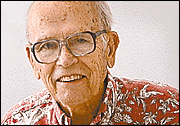Advertisement - Click to support our sponsors.


Hawaii’s World
NEXT Monday, March 12, will be 42 years since the Honolulu Star-Bulletin put out our famous extra with a single word -- STATEHOOD! -- in giant red letters across page one. Statehood was
paper’s foremost goalThat day statehood for Hawaii was approved 323-89 by the House of Representatives, following a 78-16 vote in the Senate the night before. Two Texan leaders of Congress had delivered on their promise to move a Hawaii bill speedily in the 86th Congress if President Dwight Eisenhower signed the Alaska bill passed in the 85th.
They were the Senate majority leader, Lyndon Johnson, and House Speaker Sam Rayburn. As Democrats they wanted to be sure Alaska, which had a weaker case than Hawaii and was considered to lean Democratic, would not be vetoed by the Republican president.
Ike acquiesced and gave Alaska the 49th state position Hawaii long had coveted.
Statehood was the Star-Bulletin's major goal from our founding in 1912 to its achievement in 1959 and a totally dominating goal from 1934 on.
We were not "objective" in this fight. We were wonderfully biased on the side of the angels.
By the time I joined the staff in 1946, just about every VIP visitor was asked where he or she stood on statehood, with the replies -- both for and against -- given prominent display.
Our publisher, Joseph Rider Farrington, had been Hawaii's delegate to Congress since 1942 and a territorial senator for eight years before that -- with statehood as his beacon.
When he proposed marriage to a fellow journalism student, Elizabeth (Betty) Pruett, at the University of Wisconsin in 1918, she told me he got on bended knee and told her to reject him if she couldn't accept statehood as the overriding goal of his life.
She accepted and in 1954 succeeded him as Hawaii's delegate to Congress when he died of a heart attack at his desk in Washington, D.C.
Mrs. Farrington won the July 31, 1954, special election to succeed him and a full two-year term in November, but lost to Democrat John A. Burns in the 1956 general election.
She had a keen intelligence, probably topping her husband's, and was as dedicated to statehood, but replaced his personal warmth and likability with a much more calculating temperament.
She kept them active in Washington social affairs from a posh home on Kalorama Circle. By chance, Vice President Harry Truman played the piano for guests there on the night before he became the new president of the United States.
WHETHER or not such socializing helped, Truman became the first president to advocate statehood for Hawaii in a State of the Union address.
Betty Farrington also was elected president of the National Federation of Republican Women and used that forum to speak all over America on behalf of Hawaiian statehood.
While the Farringtons carried the ball in Washington they kept in full touch with Riley H. Allen, their paper's editor back home. At considerable expense, he telegraphed all or most of each day's editorials to Washington before publication.
If possible, Allen was even a more ardent statehood advocate than the Farringtons.
I'll have more on him next Tuesday.
The election of John Burns as delegate to Congress in 1956 naturally disappointed the Star-Bulletin and its then publisher, Betty Farrington. But it didn't diminish the paper's support for statehood and had its positive side.
Burns and the two Texas leaders of Congress -- both Democrats -- worked out the Alaska-first strategy that succeeded. More delays might have occurred otherwise.
A.A. Smyser is the contributing editor
and former editor of the the Star-Bulletin
His column runs Tuesday and Thursday.